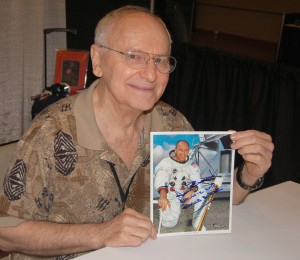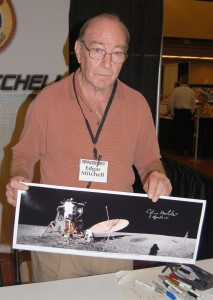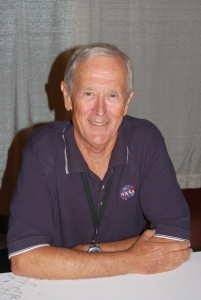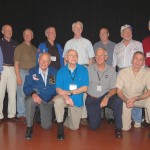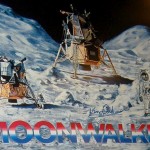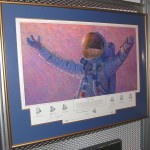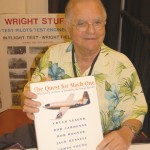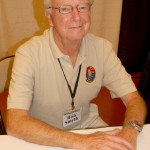
Kim Poor of Novaspace Galleries and The Planetary Society sponsored Spacefest 2007, a cosmic show that brought together 15 astronauts.
By Bob Shane
It looked like a scene from the movie “Space Cowboys,” but instead of actors Clint Eastwood, Tommy Lee Jones, James Garner and Donald Sutherland, these were real-life astronauts, including Buzz Aldrin, Scott Carpenter, Alan Bean, and Edgar Mitchell. In all, 15 NASA astronauts—seven of whom have walked on the moon—descended on the Mesa Convention Center in Mesa, Ariz. Their three-day mission was not to fix an obsolete errant Cold War-era satellite, but to sign autographs and talk about space and moonwalking at Spacefest 2007.
The theme of this year’s event was “Space Exploration: Past, Present and Future.” The show, sponsored by the Planetary Society, ran from Aug. 17-19. Kim Poor, owner of Novaspace Galleries, an Internet-based space art gallery, organized the event, which was his first show. Poor’s interest in astronomy and three decades of experience as a space artist acquainted him with a number of NASA astronauts, facilitating the coordination of the spectacular gathering.
The ambassadors of exploration from the Mercury, Gemini and Apollo programs brought together by Spacefest 2007 were Aldrin, Bean, Carpenter, Gene Cernan, Walt Cunningham, Charlie Duke, Joe Kerwin, Jack Lousma, Bruce McCandless, Mitchell, Rusty Schweickart, Dave Scott, Charles Walker, Paul Weitz and John Young.
Mercury
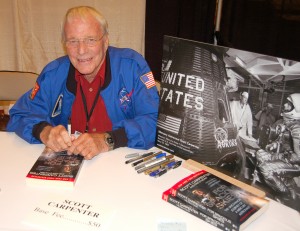
Scott Carpenter, one of the original “Mercury Seven” astronauts, signed copies of his book, “For Spacious Skies: The Uncommon Journey of a Mercury Astronaut.” Carpenter flew the second American manned orbital flight in May 1962.
Scott Carpenter was the only “Mercury Seven” astronaut to attend Spacefest. In August 1958, while assigned to the antisubmarine aircraft carrier USS Hornet, Carpenter received cryptic orders to report to Washington regarding an unspecified special project. It wasn’t until he picked up a copy of TIME magazine that he learned the newly created National Aeronautics and Space Administration had a list of 110 candidates, all military pilots, from which they would take volunteers for America’s first manned flight into space.
On April 9, 1959, Carpenter was selected as one of the original Mercury astronauts and was assigned to the Manned Spacecraft Center at Langley, Va. He served as John Glenn’s backup pilot for America’s first manned orbital flight in February 1962. Carpenter flew the second American manned orbital flight on May 24, 1962, piloting the Aurora 7 spacecraft through three revolutions of the Earth during a flight that lasted nearly five hours. He later worked with NASA as executive assistant to the director of the Manned Spaceflight Center and participated in the design of the Apollo lunar landing module.
Moonwalkers and lunar drivers
Buzz Aldrin was among the third group of astronauts named in October 1963. A lunar module pilot on Apollo 11, he followed Neil Armstrong onto the lunar surface on July 20, 1969, becoming the second man to walk on the moon. His first comment upon stepping on the moon was, “Beautiful, beautiful, magnificent desolation.”
A graduate of West Point, Aldrin flew 66 missions in F-86s during the Korean conflict, shooting down two MiGs. He’s written four books and speaks around the world advocating the privatization of space. He welcomed Mike Melvill into the astronaut club when SpaceShipOne landed in Mojave after its historic flight into space.

On July 20, 1969, Apollo 11 astronaut Buzz Aldrin landed the lunar module on the moon’s Sea of Tranquility, and with Neil Armstrong, became one of the first two humans to walk on the surface of the moon.
Walt Cunningham flew on Apollo 7 in October 1968. Commanded by Wally Schirra, the crew performed exercises including lunar orbit rendezvous with their launch vehicle, measured the accuracy of the Apollo spacecraft systems, and provided the first live television transmission of onboard activities. The mission’s success led NASA to launch Apollo 8 to the moon just two months later.
A Navy ROTC graduate who also attended the Navy Test Pilot School, Alan Bean became the fourth person to walk on the moon during Apollo 12, the second lunar landing. On his second flight, in 1973, he was the spacecraft commander of Skylab Mission II, spending 59 days aboard the world’s first space station.
Edgar Mitchell flew on Apollo 14 in 1971, becoming the sixth person to walk on the moon. His interest in human paranormal potential has been a lifelong pursuit; he even conducted ESP experiments with a colleague on Earth while he was en route to the moon.
Charlie Duke, a retired Air Force brigadier general, was selected as an astronaut in 1966. As pilot of Orion, the Apollo 16 lunar module, he became the tenth person to walk on the moon. Duke’s lunar journey included a record-setting surface stay of 71 hours and 14 minutes. Today, he runs the Duke Ministry for Christ.
John Young flew into space six times and walked on the moon during the Apollo 16 mission. He holds the record for being the only person to have piloted four different classes of spacecraft: Gemini, Apollo command/service module, Apollo lunar module and the space shuttle.
Selected to the astronaut program in October 1963, Gene Cernan’s first mission was aboard Gemini 9 in 1966. He became the second American to walk in space and was the lunar module pilot on Apollo 10. His flight on Apollo 17 earned his place in history as “The Last Man on the Moon,” the title of his memoirs.
Dave Scott served as the command module pilot for Apollo 9 in 1969. During the Apollo 15 mission, which he commanded, Scott became the first astronaut to drive a lunar rover. The vehicle made long distance lunar exploration possible.
Columbia, Challenger and Skylab
Paul Weitz served as the pilot on Skylab 2, the first manned Skylab mission, in 1973. He also was a spacecraft commander on the maiden flight of the orbiter Challenger. Weitz retired as the deputy director of the Johnson Space Center in 1994.
Dr. Joe Kerwin was selected in the fourth group of scientist-astronauts in 1965 and served as science-pilot for the Skylab 2 mission. He was subsequently in charge of the on-orbit branch of the Astronaut Office, where he coordinated astronaut activity involving rendezvous, satellite deployment and retrieval, and other shuttle payload operations. From 1984-187, he served as director of space and life sciences at the Johnson Space Center.
Bruce McCandless joined NASA in 1966. He was a member of the astronaut support crew for the Apollo 14 mission and a backup pilot for Skylab 2. He flew as a mission specialist on space shuttle missions in 1984 and 1990.
Jack Lousma also joined NASA in 1966. He was scheduled to fly on Apollo 20, but the mission was cancelled after Apollo 17 due to congressional budget cuts. He piloted Skylab 3 in 1973 and commanded Columbia in 1982.
Charles Walker flew on four space shuttle missions from 1984 through 1995 as a payload specialist. He invented and trained astronauts in the operation of an electrophoresis machine, a biomedical apparatus that was the first production device to take advantage of prolonged weightlessness.
High-flying test pilots
In addition to the astronauts, Spacefest attendees were able to meet several of the nation’s top test pilots, including Gen. Bob Cardenas, Bob Smyth, Ken Chilstrom and Ray McPherson.
Cardenas was Northrop’s chief test pilot and the pilot of the radical jet-powered YB-49 Flying Wing. He was also the B-29 pilot that carried the Bell X-1 rocket-powered research aircraft to altitude when Chuck Yeager broke the sound barrier.
The chief test pilot for Grumman, Smyth flight-tested the F9F Cougar and F11F Tiger. He made the first flights in the F-14 Tomcat, A-6 Intruder and Gulfstream II corporate jet. He also served as the astronaut liaison on the Apollo lunar module program.
Chilstrom flew early F-86 Sabre Jet flights. He also tested the first jet fighter, the German Me 262, shortly after the end of World War II. He is the author of “Test Flying at Old Wright Field,” which contains numerous anecdotes about some of the famous names in aviation.
McPherson was a Boeing test pilot involved in the flight-testing of later models of the B-52. He also tested the YC-14 cargo plane and YB-47 bomber.
“The Wonder of it All”
The highlight of Spacefest 2007 was the screening of the award-winning documentary film, “The Wonder of it All.” Not yet available to the public, it has been shown only at film festivals, museums and other special events. The independent film, produced and directed by Jeffrey Roth, contains 90 minutes of in-depth interviews with seven of the dozen astronauts who walked on the moon.
The movie shows the human side of the Apollo mission, as each astronaut talks about his life and how journeying to the moon affected him. The film provides insight into the type of person willing to leave Earth and memories from astronauts who knocked on NASA’s door until it opened.
“I kept adding credentials until they couldn’t ignore me anymore,” Edgar Mitchell explained about how he was selected.
John Young revealed the hectic schedule of Apollo astronauts.
“There was little time to be a tourist or for introspection,” he said.
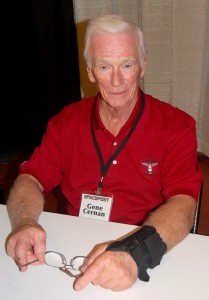
Capt. Gene Cernan was the second American to walk in space. His third flight, on Apollo 17, earned his place in history as the “last man on the moon.”
While failure wasn’t an option, it was a possibility; however, the astronauts unanimously felt the Apollo program was “a risk worth taking.”
Four showings of the film sold out during Spacefest.
Speaking about space
Over 20 speakers conducted presentations during Spacefest on such varied topics as life on Mars, images of Saturn snapped by the Cassini camera and probe from a billion miles away, Earth-approaching asteroids, the origin of the moon, the Galileo spacecraft currently orbiting Jupiter, space tourism and the legal liability surrounding commercial spaceflight.
Speaker Rick Tumlinson sells programs like the DC-X VTOL rocket, and X-33 SSTO rocketplane through videos he produces. His presentation, “Opening the Space Frontier to Everyone,” described what he calls the “new space” industry and its rise in the U.S. and around the world. Private entrepreneurs and investors fund the movement, inspired by the Apollo mission and based on the tenets of free enterprise. His talk included information about private investors who are currently building rocketships and space hotels.
Actor Richard Hatch talked about his role in “Battlestar Galactica” and his new sci-fi space series concept, “The Great War of Magellan.”
John Young gave a presentation on the “Past, Present and Future of Manned Spaceflight.” With 43 years of NASA experience, and having flown every type of manned spacecraft the agency has operated since 1965, Young is well qualified to speak about the topic. With nearly 400 people in attendance, he told the story of his first landing in the space shuttle on a 26,000-foot long dry lakebed at Edwards Air Force Base—including the fact that not everything worked well, “like the brakes.”
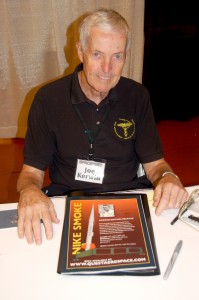
Dr. Joe Kerwin served as science-pilot for the Skylab 2 mission and was subsequently in charge of the on-orbit branch of the Astronaut Office. From 1984-187, he served as director of space and life sciences at the Johnson Space Center.
Rusty Schweickart flew the first manned flight of the lunar module during the Apollo 9 mission in 1969. He spoke about the B612 Foundation, a nonprofit organization he chairs dedicated to protecting the Earth from possible asteroids.
Dr. Phil Plait, who runs Bad Astronomy.com, spoke on debunking what he referred to as “the great moon hoax.” He addressed the belief of some individuals, referred to by Plait as “pseudo-scientists and conspiracy nuts,” that the moon landings in the 1960s and 1970s were actually filmed on a huge movie set, possibly located in Area 51.
Dr. Pat Ford, professor of Space Studies at American Military University, focuses his research on new and innovative ways of countering the negative impacts on the human neurovestibular system resulting from prolonged exposure to microgravity. He addressed the question: How can we travel for years in space and arrive on another planet alert and ready to go, instead of wobbly like Jell-O and unable to perform tasks?
Jerry Doyle, who played the Mars-born security chief Michael Garibaldi in TV’s “Babylon 5,”gave the keynote address at the Spacefest banquet. A passionate advocate of the American space program, Doyle discussed his views on science, space and the politics involved. The banquet, which accommodated 400 guests, sold out soon after it was announced in 2006.
Artists capture the essence of the universe
Space art was a major part of the Spacefest show. With more than two dozen of the top space artists in the world represented, the conference was a veritable who’s who in space art. Artists in attendance included, to name a few, official NASA artist Paul Calle, Rick Sternbach from “Star Trek,” Don Davis from PBS, Michael Carroll, Pamela Lee, Pat Rawlings, Dr. William Hartmann and Alan Bean.
Bean is known for much more than his space flights and driving matching gold Corvettes with Pete Conrad and Dick Gordon, astronaut crewmates and Navy pals, during their time in the space program. Since his retirement in 1981, he’s painted images such as Alan Shepard hitting a golf ball on the moon and Neil Armstrong smoothing out the wrinkles in an American flag planted on the moon’s surface.
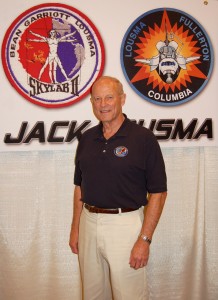
Jack Lousma supported the Apollo 9, 10 and 13 missions. He was scheduled to fly on Apollo 20, but the program was cancelled after 17, due to congressional budget cuts. He finally flew in space as pilot for Skylab 3 in 1973 and commanded Columbia in 1982.
Bean’s favorite master painter is Claude Monet. A first-class artist, Bean is equally talented in both realism and impressionism. His paintings are not only about past Apollo missions but also provide insight into the future of space exploration.
The meticulous artist only finishes one to six paintings per year. The art collector lucky enough to procure one of his coveted paintings gets a piece of artwork containing a piece of history. Before beginning each painting, Bean sprinkles a touch of moon dust over the canvas and adds finely crushed pieces from Apollo 12’s leftover heat shield or bits of gold foil insulation from an Apollo hatch. He also makes an impression on the canvas using a lunar boot or some other space tool, adding texture to the acrylic paint.
Eminent space artist Robert McCall also visited the show. McCall dedicated his career to documenting NASA and the nation’s space program. His paints and brushes have captured the drama from Mercury through the space shuttle.
Over the years, McCall has developed personal friendships with many of the astronauts, including Bean, who would often fly out in a T-38 to visit the artist, and Young, who stayed with the McCalls while visiting Mesa for Spacefest 2007. McCall designed the mission emblem for John Young’s first flight in the space shuttle as well as the emblem for Apollo 17, a flight that took another friend, Gene Cernan, to the moon. He designed 24 space-themed stamps for the U.S. Postal Service, including a stamp Dave Scott cancelled and carried to the moon.
McCall praised Poor for his accomplishment, saying Spacefest 2007 was one of the largest groups of former astronauts he’s ever seen.
“It was a remarkable and unique gathering of so many significant heroes,” he said.

Rusty Schweickart flew the first manned flight of the lunar module during the Apollo 9 mission in 1969. He’s currently the chairman of the B612 Foundation, a nonprofit organization dedicated to protecting the Earth from possible asteroids.
Spacefest covered all facets of space exploration. For space enthusiasts, it was the perfect occasion to have personal documents, books and photographs autographed, as well as to acquire original art, giclées, prints and cards. Above all, for this writer and others in attendance, the event provided the lifetime opportunity to hang out with astronauts that have been one’s heroes since childhood.
For more information, visit [http://www.novaspace.com/spacefest].
- Some of the astronauts paused for a group shot. L to R, back: Dave Scott, Jack Lousma, Charles Walker, Scott Carpenter, Rusty Schweickart, Edgar Mitchell, Buzz Aldrin, Gene Cernan. Front: Bruce McCandless, Alan Bean, Charlie Duke, Walt Cunningham.
- Now available to collectors, the limited edition lithograph “Moonwalkers,” painted by artist Ron Lewis, depicts all 12 astronauts who have walked on the moon. Eleven of the astronauts have signed it.
- “Hello Universe,” painted by Alan Bean and described as a “riot of impressionistic color,” is a celebration of the seven Navy Apollo astronauts.
- The vendor /exhibitor area offered something for everyone, from space art and books about space to models, toys and clothing.
- Retired Gen. Bob Cardenas, a top U.S. Air Force test pilot, was part of the team that broke the sound barrier. He piloted the B-29 mother ship that dropped the X-1, flown by Chuck Yeager. As Northrop’s chief test pilot, he flew the controversial YB-49.
- Bob Smyth, chief test pilot for Grumman, piloted the first flights in the F-14 Tomcat, A-6 Intruder and Gulfstream II.












